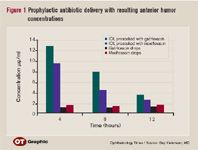Article
Presoaked hydrophilic IOL alternative for prophylactic antibiotic delivery
Salt Lake City-Implantation of a hydrophilic acrylic IOL (C-flex, Rayner) presoaked in a solution containing a fourth-generation fluoroquinolone resulted in anterior aqueous humor concentrations of antibiotic that were significantly higher and more persistent than what was achieved with a topical drop administration protocol, according to the results of a preclinical study undertaken by Guy Kleinmann, MD, and colleagues at the John A. Moran Eye Center, University of Utah Health Science Center, Salt Lake City.

"Despite lack of direct proof of efficacy, most ophthalmic surgeons chose to administer prophylactic antibiotics to prevent postoperative endophthalmitis," said Dr. Kleinmann, who is adjunct assistant professor of ophthalmology, Moran Eye Center.
"A significant increase in resistance to ciprofloxacin has caused a switch to use of a fourth-generation fluoroquionolone. Topical administration of the latter agents can result in anterior chamber concentrations of antibiotic that exceed the MIC90 for Staphylococcus epidermidis, but for only a very short time," he said. "The results of our study indicate this IOL may provide a better method for drug delivery."
Study protocol
The study was performed in a rabbit model and involved two groups of 15 animals each.
In one group, hydrophilic acrylic IOLs that were presoaked for 24 hours in the commercially available solutions of moxifloxacin 0.5% (Vigamox, Alcon Laboratories) or gatifloxacin 0.3% (Zymar, Allergan) were implanted into contralateral eyes of the same animal.
The second group of animals was treated with a topical fluoroquinolone administration protocol before and after implantation of a standard C-flex IOL. Each animal received moxifloxacin in one eye and gatifloxacin in the fellow eye administered every 5 minutes for three doses at 1 hour before surgery and then every 2 hours after surgery. Aqueous humor samples were obtained at 4, 8, and 12 hours after implantation in all eyes, and antibiotic concentrations were measured using high-performance liquid chromatography.
Eyes that received the presoaked IOLs achieved very high peak concentrations of moxifloxacin and gatifloxacin that decreased over time. Comparisons between the two fluoroquionolones showed significantly higher concentrations were achieved at 8 and 12 hours with gatifloxacin.
In eyes receiving topical treatment, the concentrations of antibiotics were stable over the sampling period and were higher for moxifloxacin (1.6 to 1.9 μg/ml) compared with gatifloxacin (~1.0 to 1.2 μg/ml), he said.
"The results achieved with the topical drops are similar to what has been reported in other published studies. The differences in concentrations achieved between antibiotics were not statistically significant at any sampling time, probably due to low numbers of samples," Dr. Kleinmann said.
Comparisons between eyes receiving the presoaked IOL and those treated with topical antibiotic showed aqueous humor concentrations were significantly higher at all time periods in the eyes with the presoaked IOL implanted, except at 12 hours for moxifloxacin.
Slit-lamp assessments over the 24-hour period after surgery revealed no signs of toxicity in any group.




